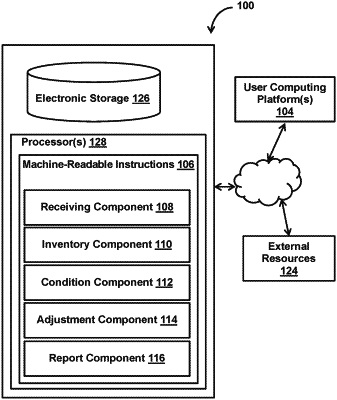| CPC G06Q 30/0205 (2013.01) [G06F 3/04842 (2013.01); G06F 16/29 (2019.01); G06N 3/044 (2023.01); G06N 3/08 (2013.01); G06N 20/00 (2019.01); G06Q 10/06395 (2013.01); G06Q 10/0875 (2013.01); G06Q 30/0206 (2013.01); G06Q 40/08 (2013.01); G06T 7/0002 (2013.01); G06T 7/20 (2013.01); G06T 7/50 (2017.01); G06T 7/80 (2017.01); G06T 17/00 (2013.01); G06T 17/20 (2013.01); G06V 10/764 (2022.01); G06V 10/82 (2022.01); G06V 20/00 (2022.01); G06V 20/64 (2022.01); H04N 23/631 (2023.01); G01S 17/06 (2013.01); G01S 19/42 (2013.01); G06F 18/24 (2023.01); G06Q 50/16 (2013.01); G06T 2207/20081 (2013.01)] | 23 Claims |

|
1. A system configured for generating an inspection report utilizing a machine learning model, the system comprising one or more hardware processors configured by machine-readable instructions to:
receive description data of a location, the description data generated via at least one of a camera, a user interface, an environment sensor, and an external location information database;
generate an inventory list comprising a plurality of items at the location, utilizing the machine learning model, based on the description data, the inventory list further comprising inventory attributes associated with the plurality of items related to a context of the plurality of items at the location;
determine, utilizing the machine learning model, based on the description data, interior and/or exterior condition information for the location, the interior and/or exterior condition information describing a quality of structural components of the location and hazards in and/or around the location;
the hazards determined by multiple stages of the machine learning model configured for predicting physical hazards at the location, the physical hazards changing over time and from location to location, each stage of the multiple stages being improved based on a required computing capability and a maximum allowable processing time for a given stage to minimize overall computing resources and processing time for the multiple stages, the hazards determined by:
predicting, with a first stage of the multiple stages, a potential hazard type based on the received description data, the potential hazard type comprising one potential hazard type of a set of predetermined potential hazard types, the first stage having a first configuration improved for potential hazard type predictions based on the received description data; and
predicting, with a second stage of the multiple stages, based on the predicted potential hazard type and the received description data, a physical hazard at the location, the second stage having a second configuration that is different from the first configuration, the second configuration associated with the predicted hazard type without regard for other potential hazard types, the second configuration improved for predicting the physical hazard at the location once the hazard type is predicted by the first stage, and
generate, utilizing the machine learning model, based on the inventory list and the interior and/or exterior condition information, the inspection report for the location.
|